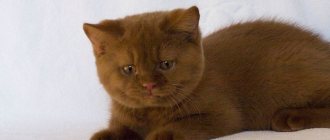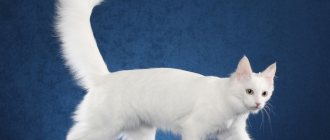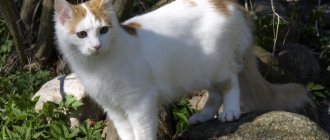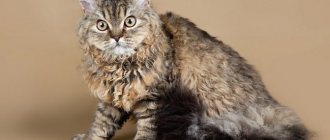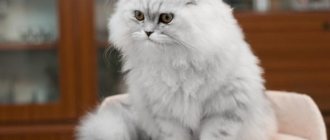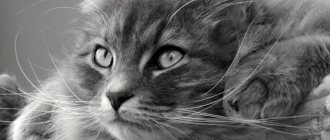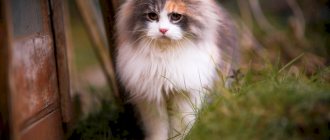Havana Browns are graceful, narrow-faced cats with movable locator ears and fur with a uniform brown tint. Interesting appearance, high intelligence and amazing character make them an object of increased interest among connoisseurs of rare breeds. But before you get a green-eyed beauty in a chocolate fur coat, you should figure out what else is hidden behind the exotic appearance of the Havana Brown.
Brief history of the breed
The Havana Brown breed originated in England. Although the first records of similar cats date back to the 1800s, deliberate selection began in the 1950s. The breeding of the Havana began with the light hand of three breeders - Baroness Miranda von Ullman, Mrs. Fisher and Anne Hargreaves.
To achieve their goal, the women used chocolate and seal point Siamese and black shorthaired domestic cats. At some point, the blood of Russian Blues was added to the mestizos, but its genes are absent from the DNA of modern Havana.
The new breed received official status in 1958. Around the same time, part of the livestock was exported to the United States. Due to problems with genetics, representatives of the English line began to be crossed with cats of other breeds. Because of this, their fur acquired a variety of shades, and they themselves began to be called the chestnut oriental cat. Unlike their British counterparts, American breeders only bred cats with chocolate coats. It was they who received the name “Havana Brown”.
Interesting Facts
You can tell a lot of interesting things about this breed. Here are some fun facts:
- Havanas are suitable for people prone to allergies to cat hair. Due to the short coat and rare shedding, there will be no health problems.
- Oriental cats are widely called “rainbow”. This is because they come in multiple colors.
- Due to the lack of undercoat, cats cannot tolerate low air temperatures. Therefore, they must be protected from drafts and not allowed outside in winter.
- With good care they can live up to 20 years. Because of this, they are considered to be long-livers.
- They are remarkable for drinking water from a bowl. Sometimes they start scooping it up with their paw and bringing it to their mouth.
- In the absence of attention from the owner, they begin to meow loudly and show their displeasure in every possible way.
- Sometimes Havanas get jealous. This applies not only to family members, but also to a specific place or object.
- Cross-eyed Havanas are sometimes found. Such a phenomenon is not acceptable according to the standard and is listed as a defect.
- Havana cats rarely use their claws. Therefore, they will be the best friends for children.
- There is a version that Havanas are telepaths - their intuition and sensitivity are so highly developed, which is unusual for other representatives of the cat family.
- They often begin to copy the behavior of their owner. Therefore, many cats begin to go to the toilet in a human way - on the toilet.
Breed description, standards, appearance
The Havana Brown is a graceful cat with well-developed muscles and short hair. Visually, it resembles the Siamese, but differs from them in having green eyes, an elongated narrow muzzle, large ears and a uniform brown color.
Dimensions and weight
The Havana is a medium-sized cat with moderate sexual dimorphism. The average weight of a female is 2.5-4 kg. The weight of a male can reach 5 kg.
Anatomical characteristics
According to the first and only true TICA standard, a Havana Brown cat must meet the following description:
- The head is elongated, with a rounded muzzle, pronounced cheekbones, a prominent profile and a protruding chin.
- The eyes are large, expressive, almond-shaped. The Havana iris is bright green. In kittens under one year of age, the color of the eyes may change.
- The cat's ears are set wide and slightly tilted forward. The shells are large, with rounded tips.
- The body is elegant, slender, with developed muscles, strong bones and minimal fat reserves.
- The limbs are proportional, with developed joints. The front legs are slightly shorter than the hind legs, which is why the Havana's croup appears slightly raised. The paws are compact, with pink pads.
- The tail is long, with a pointed tip.
Color and coat type
The Havana is a short-haired cat breed with smooth, glossy, chocolate-colored fur. The animal's coat may have a red-brown or brown-violet tint. The color of the Havana's whiskers should match the color of the coat. The nose is pigmented brown with a pink tint.
On a note. Havana Brown kittens can have a tabby pattern. But by the age of one year, the spots and stripes on their coat completely disappear.
Possible breed defects
Flaws in appearance, in the presence of which the Havana will be disqualified and classified as a representative of the pet class breed:
- creases and curvatures of the tail;
- spots and medallions;
- polydactyly;
- iris color other than green;
- discrepancy between the shade of the mustache, nose and fur;
- not pink paw pads.
How much does it cost and where to buy
The Havana cat breed is not very widespread around the world. In total, a little more than a hundred official representatives of this species have been registered, so the cost per kitten will be at least $900, which in translation at today’s exchange rate is equivalent to 57 thousand rubles. or to 23.5 thousand UAH.
There are just over a hundred purebred Havanas in the world, so the price of a purebred cat is quite high. Depending on the pedigree, it reaches $2,000.
Catteries that offer Havana Brown kittens can be found in the USA and Europe. In Russia, Ukraine and Belarus, there are only nurseries where Siamese and Oriental kittens are bred.
Havana kittens begin to be sold when they reach 4-5 months. By this age, the characteristics of the breed appear. Cats are rarely sold due to their limited number and the need to produce offspring.
Character and temperament
The Havana Brown is a sociable cat and does not tolerate loneliness well. If an animal is left to its own devices for a long time, it can become depressed and get sick. Unlike many cats, the Havana actively uses its paws. With them she touches objects that interest her and attracts the owner's attention.
The playful and talkative Havana gets along well with children of all ages and gets along well with other pets. She can scratch only through negligence. And if the Havana Brown doesn’t like something, it won’t hiss or release its claws - the cat simply retreats with a loud meow.
Photo of the Havana Brown breed
Formidable but not dangerous
Havanese are interested in everything that happens around them
Comfortable to sit on the owner's shoulder
Truly an important person
Fit for royalty
Apparently tired, lay down to rest
How to choose the right kitten
Havana Brown is a rare breed, the bulk of whose livestock is concentrated in the United States and Western Europe. Therefore, it is better to look for a purebred kitten in a foreign cattery.
When choosing a potential pet, you should pay attention to the following nuances:
- availability of pedigree and veterinary passport;
- conditions of detention;
- behavior;
- condition of the kitten's eyes, ears, skin and fur.
On a note. A small kitten may not have a “Cuban” appearance and this must be taken into account when purchasing. Spots and stripes are acceptable on the baby Havana's coat, as well as rings on the tail.
Kitten care
The Havana Brown kitten is ready to go to a new home after it turns 3 months old. Therefore, separating a baby from his mother before this age is not only impractical, but also dangerous for his health. By this time, he manages to receive all the necessary vaccinations, gain basic immunity and learn basic hygiene skills.
Before the kitten arrives, it is advisable to purchase everything you need to care for it:
- bowls for water and food;
- tray with filler;
- bed or house;
- grooming tools (toothbrush, combs, etc.);
- hygienic cosmetics (shampoos, lotions for cleaning ears, etc.);
- toys.
To begin with, the kitten is given several days to adapt and get to know the house. And so that it passes without injury, all potentially dangerous things are removed from the Havana baby in advance: indoor plants, detergents, breakable objects and wires. Close windows and balconies, and also check the insides of ovens and washing machines before turning them on.
The kitten is fed on a schedule that depends on its age. At first, the little Havana is given food 5-6 times a day. Gradually, portions are increased and the number of meals is reduced.
Diseases
With an average life expectancy of 15 years, Havanas are prone to certain diseases:
- cardiomyopathy;
- inflammation of the gums;
- renal failure;
- respiratory tract diseases.
In order for your pet to be healthy and enjoy life, you need to monitor its diet (buy only high-quality food, feed it no more than 3 times a day) and periodically take it to the veterinarian for examination.
Care and maintenance
Havana is an unpretentious cat; he does not need specific conditions. To maintain a neat appearance, it requires minimal hygienic care:
- To make a cat's chocolate coat look aesthetically pleasing, it is regularly treated with a special rubber glove. In normal times, the procedure is carried out once a week. During the molting period, the Havana Brown is combed more often. The cat is bathed once every 2-3 months using special shampoos for short-haired breeds that do not dry out the skin and do not cause allergies.
- To remove plaque and prevent dental diseases, the cat's teeth are brushed three times a week with a soft brush and a small amount of non-foaming paste.
- The Havana's claws are trimmed with a nail clipper as they grow. In this case, only the transparent ends are removed.
- The cat's eyes and ears are regularly inspected for any unusual discharge and cleaned with a moistened cotton swab.
Havana cat care
There are recommendations on how to care for cats of this breed.
How to care for your fur
Caring for the fur of these beauties is not difficult. Once every two weeks you need to brush it for 10 minutes. It is recommended to bathe them once a month. Cats take bathing calmly. After the procedure, you need to wipe the cat dry with a terry towel.
Feeding Havana cats
Havanas are not prone to overeating. It is recommended to feed your cat food with a high protein content. In order for the gastrointestinal tract to function normally, you should feed your cat not only dry food, but also wet food. If you decide to switch your four-legged friend to a natural diet, you need to ensure that the diet is mainly protein, with a minimum content of carbohydrates. Meat in the diet should be at least 70%.
Important! If you are using premium food, you need to purchase a measuring cup and measure the amount of food according to the weight and age of your pet.
Hygiene and toilet
It is recommended to wipe Havana eyes daily with a damp swab. Ears need to be cleaned once every two weeks. Once a week you need to gather courage and patience and brush your pet’s teeth. Brushing your teeth will prevent plaque and tartar from building up on your teeth.
It is better to choose a closed toilet, as at such moments they love privacy.
Important! You need to wash your paws every two to three days. Since all cats bury what they've done in the litter box, it's possible that something might get on their paws.
Castration and sterilization: when should surgery be performed?
If you don’t have time to breed kittens, then it is better to castrate (sterilize) the animal. The most optimal age for the procedure is from 6 months to 1 year.
Buying Havana kittens
Feeding the cat
To maintain health, the Havana Brown needs a nutritious diet with vitamins and microelements. Many modern breeders advise feeding their pets with high-quality premium or super-premium dry food from trusted global manufacturers. This cat food already contains the balance of substances for the normal functioning of the animal’s body, and the owner does not need to independently think through the menu and calculate the proportions.
Havana Brown cats eat the following brands of food quite well:
- Brit Care;
- Farmina;
- Pronature;
- Monge.
Adherents of natural food recommend giving your cat fresh lean meat, cereals, vegetables and fermented milk. It is advisable to include offal, eggs and ocean fish into the Havana Brown's diet twice a week.
Important! Cats of this breed are prohibited from giving fatty meat, river fish, smoked meats, pickles, sausages, sweets, baked goods and any food from the master's table.
Socialization of a pet
Along with predatory habits comes irrepressible activity. The cat does not know how to sit still and does not like to sit still. Her life is movement. And the faster it is, the more comfortable it is. She is inventive and clever in games. Loves to play with children. When playing, she is careful and not malicious. He does not use claws on children, and in case of danger, he is prudently removed.
A cat needs a companion, so it is better to get a breed for those who are often at home. It is not recommended to leave Havana alone. Having lost her friends, she falls into deep despondency, loses her appetite and the meaning of her existence.
It is not recommended to leave Havana alone
If the owner is forced to go away, it is better to have two cats at once. In this case, only a companion of the same breed is suitable for Havana.
Sociable pets
If necessary, she will get along with other pets. Havana is able to become friends even with a dog. The main thing is that the roommate is not in the category of potential dinner, otherwise predatory genes will sooner or later play their role.
An outstanding trait of the breed is talkativeness. Havana loves to chat and verbalize everything she sees. Her meowing is unobtrusive. The cat prefers to drown hearts not with volume, but with melody. In moments of joy, I don’t mind purring.
Among household members, he prefers not to choose a favorite, but to love everyone indiscriminately. She is affectionate and even capable of being cunning in order to earn a little attention.
He treats the rules in the house with respect, but he cannot tame his habits. So, the pet loves to use its paws, so it will definitely touch all the objects in the house with them. The animal loves to lightly touch things, often knocking over vases and cups.
Havana kitten
Raising a cat is not difficult. It is enough to communicate with her and give commands in a confident tone. Havana won't argue. She is ready to obey in any situation.
Education and physical activity
Havana Browns are moderately temperamental and active cats. They love to climb to high places and watch what is happening from there. Therefore, Havanas need special sports corners with various platforms and ladders on which they can climb and jump.
Cats of this breed are distinguished by a high level of intelligence and good memory. They are easy to train and quickly get used to a certain routine. To train a cat, you just need to communicate with it and give commands in a confident voice.
Health and characteristic diseases
Handsome Brown
Overall, the Havana Brown can boast of excellent health. These representatives are endowed with strong immunity from birth and are not predisposed to genetic diseases. But they also tend to periodically suffer from some infectious feline diseases. Typically, health problems appear at a young age.
Havanas have adopted a number of diseases from the Siamese:
- kidney pathologies;
- disorders in the respiratory system;
- inflammation of the oral mucosa;
- heart failure.
In order for your pet to live as long as possible, it is recommended to visit the veterinarian more often for follow-up examinations and to vaccinate on time.
Vaccinations and antiparasitic treatment
To prevent infectious and viral diseases, Havana Browns are regularly vaccinated. The first vaccination against calcivirosis, rhinotracheitis and panleukopenia is given to a kitten at the age of 7-8 weeks.
After 28 days, the baby is vaccinated against the same diseases and against rabies. In the future, Havana Brown is vaccinated once a year.
Twice a year, a cat of this breed is given anthelmintic drugs. The dose of the drug is calculated taking into account the body weight of the animal. To combat fleas, special shampoos, drops and anti-parasitic collars are used.
Buying Havana kittens
The breed is one of the rarest. To find the true Havana, you have to work hard. It is better to study information about all the nurseries that exist in Russia.
Before you make a purchase, you need to familiarize yourself with all the documents for the kitten’s parents and the kitten itself. The description of the parents should include age, their ancestors, titles (if any), diseases that the cats suffered. And most importantly, you need to check the license of the nursery.
Important! A good cattery will not sell a cat before 3 months.
The price for a Havana baby ranges from $500 to $1,000.*
Pros and cons of the breed
By analogy with cats of other breeds, the Havana Brown has both advantages and disadvantages:
| pros | Minuses |
| Interesting exterior | Intolerance of loneliness |
| Low maintenance | Rarity of the breed |
| High intelligence |
Havana Brown is a beautiful cat with a sophisticated appearance, a rare chocolate color and a good-natured, sociable disposition. She easily makes contact with people and will be an excellent companion to someone who surrounds her with attention and care.
Psychological picture
They are almost always in a cheerful mood, they love to be the center of attention, they are playful and sociable. They become strongly attached to the owner, so a warning to those who decide to have cats of this breed - from lack of attention and care, the Havana gets sick, and a long separation from the owner (if you are going on a business trip, for example) is a terrible stress, this can make the animal very sad and even wither and die. To prevent this from happening, it would be better if there are two or several cats of the same or other breeds in the house. Havana will delight all other felines and involve them in her daily routine and home inspection process.
Havana cats are very sociable, adapt well to any family, get along with children, are not aggressive, and easily get used to other pets.
The main thing for them is to show off, to earn attention and admiring glances. This is a perpetual motion machine of games and pranks - it is impossible to stop. The greatest happiness for these cats is to be the center of attention of a person and for him to play with them
Although Havanas are not very intrusive, they really need communication with a person. They sense the owner’s mood well and know how to adapt to it. Even if he is very busy and does not have time to pay enough attention to Havana, a friendly representative of this breed will prefer to be in the same room with the owner in the hope of getting his share of love and affection, rather than playing mischief, going in search of adventures around the house or inspecting the farthest corners of the home
The greatest happiness for these cats is to be the center of attention of a person and for him to play with them. Although Havanas are not very intrusive, they really need communication with a person. They sense the owner’s mood well and know how to adapt to it. Even if he is very busy and does not have time to pay enough attention to Havana, a friendly representative of this breed will prefer to be in the same room with the owner in the hope of getting his share of love and affection, rather than playing mischief, going in search of adventures around the house or inspecting the farthest corners of the home.
The cat also has a relatively quiet voice - a godsend for those who do not really like the loud and mournful meow of those who want to get their pet. Havana's character is strong and balanced, and, of course, like all cats, there is some laziness - they love to sleep, curled up in a ball and cuddled with a fluffy chocolate barrel to another cat or to the owner.

